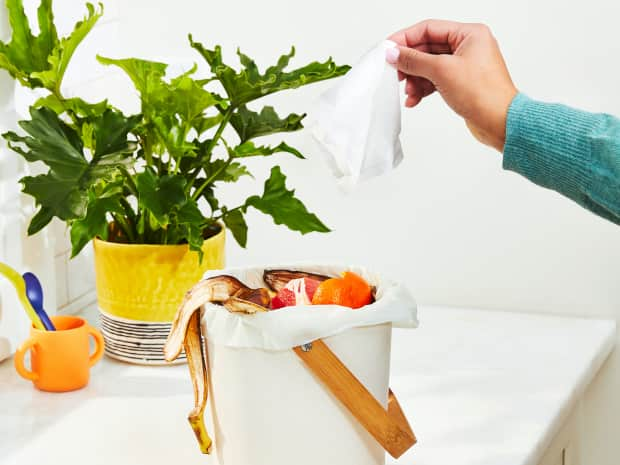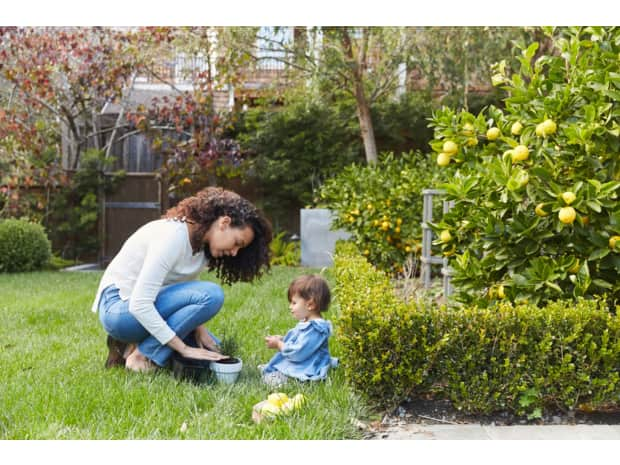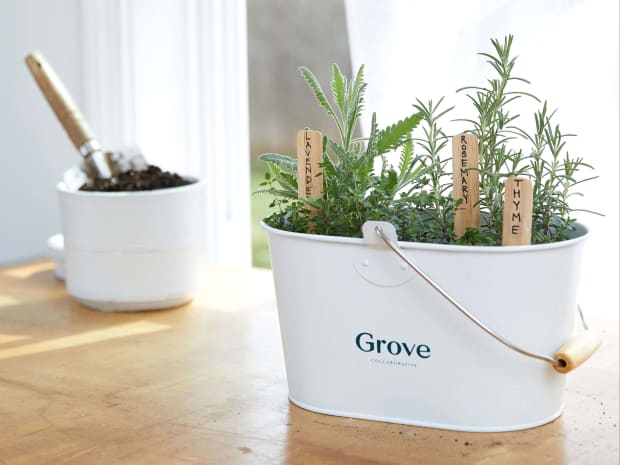
How to Get Rid of Weeds Without Using Chemicals
Tired of weeds threatening your lawn, veggies, or flowers? Learn how to get rid of weeds the natural way.
Read More


Last Updated: July 12, 2022
Composting might seem like the kind of eco-friendly hobby reserved for die-hard environmental enthusiasts, but it's actually a surprisingly simple step towards living more sustainably. Read our easy-to-follow guide for beginners.
It’s estimated that about 95 percent of food scraps in the US end up in landfills. “Doesn’t it just decompose in the landfill?” You might ask. Well, yes — but when food waste is left to rot in landfills, it emits the greenhouse gas methane — perpetrator of a whole host of environmental problems.
The good news is that when food scraps are composted, they don’t emit sinister gasses — in fact, composting food scraps instead of trashing them significantly reduces methane emissions from landfills, lowering the amount of personal waste each home produces.
Whether you’re chillin’ in the ‘burbs or living the high life in an apartment, we’ve got tips to help you start composting ASAP.

Compost is what naturally happens when organic materials like food scraps and yard waste decompose with the help of oxygen and microorganisms like bacteria and fungi. The resulting material – which looks a bit like dark, fluffy dirt – is loaded with nutrients and makes an excellent fertilizer for houseplants, gardens, and plant-loving family members.
Learn the difference between compostable and biodegradable materials with our in-depth guide.
Continuous composters are the easiest to use because they’re more low-maintenance than other compost bins. All you do is find a spot for it outdoors, toss in your compostables, and wait. Turning the food scraps helps the material compost more quickly, but it’s not necessary with this type of bin.
Batch composters and compost tumblers are the quickest way to get compost. Unlike continuous composters, where you’re constantly adding to the bin, batch composters require you to save up enough organic material to cook up one large batch of compost. After material is added to the tumbler, turn it five to ten times every three days. In about two weeks, you’ll have ready-to-use compost.
Worm composters, also called vermicompostor worm bins, are exactly what they sound like — worms, specifically red worms, are used to eat up kitchen scraps and other organic materials. The result of their “castings,” aka worm poop, is a super-rich compost that’s jam-packed with phosphorus, nitrogen, and other micronutrients.
Learn more fun and eco-friendly ways to prevent food waste with our fruit picking guide.



Recycle empty packaging with panache using our simple and easy guide.
Countertop bins and compost sacks made to collect kitchen scraps are a treat because they prevent odor from escaping, but in a pinch you could use anything from an empty coffee canister to a piece of tupperware.
To keep your compost bin happy and bug-free, it requires what’s often referred to as “compost lasagna.” This is a relatively even mix of nitrogen rich wet “greens” and dry carbon rich “browns”. Greens are things like kitchen scraps and grass, while browns include egg cartons and newspaper. This dynamic duo creates an ideal environment for compost-creating microorganisms to thrive.
To make compost lasagna, put down a layer of browns, then add a layer of greens on top. That’s it! The browns also help sop up the wetness from the greens, preventing your compost bin from turning into a soupy mess.
Grove Tip
Food scraps take about 8 to 12 weeks to decompose and turn into usable compost. If you’ve got a compost bin outside, keep in mind that the decomposition process stops during cold weather.
If you have the outdoor space to devote to composting, it's as easy as 1-2-3 to getting started with composting — source your bin, set down the compost foundation, and turn.
Pick the type of compost bin you want to use — compost tumbler, premade continuous compost bin, or DIY compost bin — then figure out where you want to put it in your yard.
Start making your compost lasagna. After you’ve added the last of your food scraps, top it off with another layer of browns to keep bugs out, then put the lid on your compost bin until next time.
Aeration is key for decomposition: Microbes need oxygen to survive. How often you need to turn depends on a number of factors, including the size of your compost pile. The general rule of thumb is to turn new compost every three to seven days, but some people wait four to five weeks for more mature piles. Waiting this long provides enough time for the microorganisms to heat up and start the decomposition process.
Some outdoor compost bins come with built in tumblers, but open compost piles will need to be turned over manually with a shovel or fork (not so different from tossing a salad). And if you have the space (and funds), you can invest in a multi-bin composter that allows you to turn compost from one bin to the next.
The best way to compost in an apartment is with vermicomposting (that is, letting worms break down your waste). We promise you won’t have a mass exodus of creepy crawlers parading through your pad.
Drill holes into a plastic container with a lid. These act as air holes for the worms.
Not just any worms will do — only red worms are suitable for compost. Uncle Jim’s Worm Farm is a popular destination for vermicomposters looking for high-quality squiggly boys.
You can purchase bedding for vermicomposting, or you can use cut up pieces of cardboard and newspaper. Whichever you choose, lay it out in an even layer so it covers the bottom of the container. Get the bedding slightly damp so that it’s wet to the touch but not sopping.
Time to add the boys! Empty your worms into the container, and cover them with more slightly damp bedding, newspaper, or cardboard. Worms don’t like light and will probably head for cover under their bedding.
Slowly begin adding food scraps. Start with a few handfuls. If the worms eat it all, add more. If some of the scraps rot, remove them from the bin and feed the worms less. Top the scraps with more damp newspaper, then pop the lid on your worm bin and store it in a dry, dark place.
Keep adding kitchen scraps to your bin as they accumulate, but make sure there’s never more than 1/2 inch of scraps in any one spot. Always add a few browns in with your greens to keep moisture down. There’s no need to turn your vermicompost — the worms mix it enough on their own.
Don’t let apartment life stop you from having a garden. We grew an indoor microgreens kit in an NYC apartment and reported back with our (successful) findings.
These services help people who don’t have the time or space to manage their own compost systems by picking up food scraps and other compostable waste and doing the dirty work for you.
So, home composting vs. municipal composting vs. industrial composting — what’s the diff? Municipal compost systems, such as curbside compost pick up programs, are used by some cities to collect compostables like food scraps, yard waste, and even roadkill from their communities. These collection services can pick up any home compost you aren't reusing for gardening, and these items are taken to medium-scale facilities where they’re turned into compost.
Industrial composting, aka commercial composting, is composting done on a much larger scale. Industrial composters pick up compostable waste generated by grocery stores, restaurants, green waste bins, and plant nurseries. From there, commercial composters decompose the waste under controlled conditions then prepare the compost to be sold to farms and plant nurseries.
From natural household to personal care, everything at Grove is healthier for you and the planet — and works! We recommend monthly shipments and product refills that you can edit or move at any time. No monthly fees or commitments required.

Tired of weeds threatening your lawn, veggies, or flowers? Learn how to get rid of weeds the natural way.

Working on your green thumb? Let us guide you through the differences between gardening with soil vs. dirt.

We've pulled the top 14 best indoor garden kits determined by Grove members.

We've pulled the top 11 compostable household products as determined by Grove members.